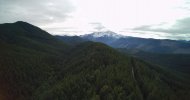- Joined
- Oct 14, 2019
- Messages
- 66
- Reaction score
- 33
- Age
- 49
I was flying in the foothills leading up to Mount Rainier yesterday and launched the drone from an altitude of 3280 feet and went up 400 feet to 3680 feet. That's just a hair under 0.7 miles above Sea Level. The air should be thinner there but to be honest I can't say that I noticed anything different at all in the way the drone performed.
Was the altitude not really that much of a factor? How high above Sea Level does the drone have to be to start to be significantly affected by the thinner air? What performance factors are the most affected? Lift? Time to Climb? Stability? Handling? Flight Time?
Was the altitude not really that much of a factor? How high above Sea Level does the drone have to be to start to be significantly affected by the thinner air? What performance factors are the most affected? Lift? Time to Climb? Stability? Handling? Flight Time?



